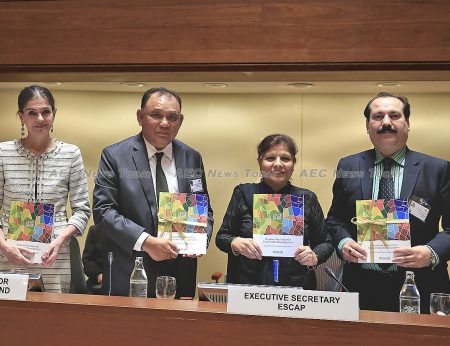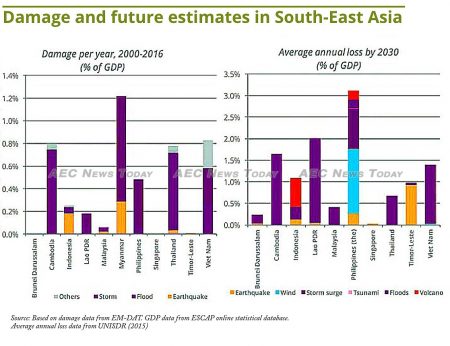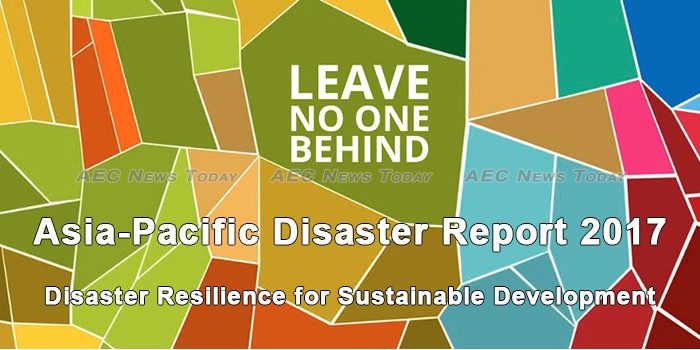Senior policy makers from across the Asia-Pacific have taken the first steps in improving the regions preparedness to meet natural disasters with the establishment of the Asia-Pacific Disaster Resilience Network (APDRN).
The initiative was among several agreed on by delegates attending the first Disaster Resilience Week seminar in Bangkok last week. The APDRN will draw on data from the United Nations Economic and Social Commission for Asia and the Pacific (Escap) to provide increased resilience and improved natural disaster risk reduction in line with the UNs Sustainable Development Goals (SDGs).
Speaking at the release of Escap’s Asia-Pacific Disaster Report 2017, which coincided with the meeting getting underway, Escap executive secretary Shamshad Akhtar called for more concrete action in improving disaster warning systems throughout the region. The failure to do so, she warned, could see the region accounting for 40 per cent of global GDP losses due to natural disasters by 2030, despite it only contributing about 36 per cent to global GDP.
According to the report, prefaced ‘Leave No One Behind: Disaster Resilience for Sustainable Development’, natural disasters cost the AP region some $1.3 trillion between 1970 and 2016.

Describing the AP region as “the most disaster-prone region in the world”, Ms Akhtar said that the incidence of natural disasters is becoming more frequent, with disaster risk outstripping resilience.
Earthquakes, storms, and floods wrought the most destruction, she said, with the greatest burden of loss as a proportion of GDP being borne by Small Island Developing States (SIDS) (4 per cent loss), and least developed countries (LCDs) (2.5 per cent loss).
SIDS and LCDs were the hardest hit from a humanitarian perspective also.
Between 2000 and 2015 the report says more than 8,000 people died per disaster – almost 15 times the average toll in the region’s high-income countries.
Natural Disasters: 2 Million Dead in Asia Pacific

While noting that 2016 saw fewer deaths caused by natural disasters than in previous years — 4,987 people were recorded killed in natural disasters throughout the AP region in 2016 — Ms Akhtar noted that since 1970 natural disasters have killed two million people in the region, 57 per cent of the global death toll.
While this partly corresponds to the regions size — the AP region accounts for 60 per cent of the world’s population and 40 per cent of its landmass — a person living in the Asia Pacific region is much more likely to be affected by natural disasters than those in other locations.
Of particular concern is that the population in the ‘extreme-risk’ areas, is expected to grow more than 50 per cent in 26 cities, and by 35-50 per cent in 72 cities, by 2030.
Against this backdrop the World Risk Report 2016 notes that eight of the ten countries at greatest disaster risk in Asia and the Pacific have low coping capacity, with the two exceptions being Japan and Brunei Darussalam.
In addition to calling for the development of more, robust early warning systems, Ms Akhtar also said more innovative sources of disaster risk financing was needed to protect people’s livelihoods .
“Disasters can very quickly strip poor people of their livelihoods bringing deeply disruptive impacts that push them back into absolute poverty or trap them in an intergenerational transmission of poverty. Developing cost-effective financing is needed to decrease the existing resilience gaps.
“The absence of an institutionalized insurance culture and adequate post disaster financing threaten our extraordinary economic and developmental achievements. Promoting more, and deeper, collaboration among countries in the region on disaster risk financing will be an ESCAP priority”, she said.
Natural Disaster’s to Hit Philippines GDP Most

According to the Asia-Pacific Disaster Report 2017 the Philippines, with some 20 tropical cyclones per year, will suffer the greatest GDP losses from natural disasters in Asean by 2030. Damage and resultant industry downtime is expected to cost the Philippines more than 3 per cent of GDP.
Flood damage is expected to strip 2 per cent from Lao PDRs GDP by 2030, about 1.6 per cent from Cambodia GDP, and about 1.4 per cent from Vietnam GDP.
Much of this is moot though. Between 2000-2016 Myanmar is recorded as having suffered the largest reduction in GDP from natural disasters, with 0.9 per cent of the 1.2 per cent whack to its economy caused by a single cyclone; Cyclone Nagris in 2015.
Cyclone Nagris was also the largest cause of loss of life in Asean over the period, which saw some 362,000
reported deaths and more than 259 million people affected by natural disasters.
The release of the report comes ahead of the fifth Asean Ministerial Meeting (AMM) on Disaster Management scheduled to be get underway in Luang Prabang, Lao PDR, on Tuesday, October 17, at which natural disaster preparedness is a major topic.
According to a report in the Lao state-run Lao News Agency (KPL) last week, the meeting will emphasize the importance of public awareness, community participation, promoting partnerships and collaboration, and mainstreaming disaster management in the development process,
The meeting will also discuss implementation of two documents approved by Asean leaders in Vientiane, Lao PDR, last September — the Asean Agreement on Disaster Management and Emergency Response and the Asean Declaration on One Asean One Response.
Meanwhile, the death toll from landslides and heavy in northern Vietnam has reached 68, with another 34 people missing. Some 230,000 head of livestock are also reported to have been killed.
Download your copy of Escap’s Asia-Pacific Disaster Report 2017.
Related:
- ASEAN ministers to meet in Laos to discuss disaster (Xinhua Net)
- Asia-Pacific Disaster Report 2017 (UNESCAP)
- Leave No One Behind: Disaster Resilience for Sustainable Development – Asia-Pacific Disaster Report 2017 (ReliefWeb)
Leakhena Khat in Phnom Penh contributed to this report
John Le Fevre
He has spent extensive periods of time working in Africa and throughout Southeast Asia, with stints in the Middle East, the USA, and England.
He has covered major world events including Operation Desert Shield/ Storm, the 1991 pillage in Zaire, the 1994 Rwanda genocide, the 1999 East Timor independence unrest, the 2004 Asian tsunami, and the 2009, 2010, and 2014 Bangkok political protests.
In 1995 he was a Walkley Award finalist, the highest awards in Australian journalism, for his coverage of the 1995 Zaire (now Democratic Republic of Congo) Ebola outbreak.
Prior to AEC News Today he was the deputy editor and Thailand and Greater Mekong Sub-region editor for The Establishment Post, predecessor of Asean Today.
In the mid-80s and early 90s he owned JLF Promotions, the largest above and below the line marketing and PR firm servicing the high-technology industry in Australia. It was sold in 1995.
Latest posts by John Le Fevre (see all)
- COVID-19 in Asean: update for July 26 — 16 mln case barrier breached, Vietnam records community transmission – July 26, 2020
- COVID-19 in Asean: update for July 25 — new high for daily infections, 16 mln infection barrier to break today – July 25, 2020
- COVID-19 in Asean: update for July 24 — Asean tops 230,000 cases, nudges 90,000 active – July 24, 2020
- Thailand morning news for July 24 – July 24, 2020


